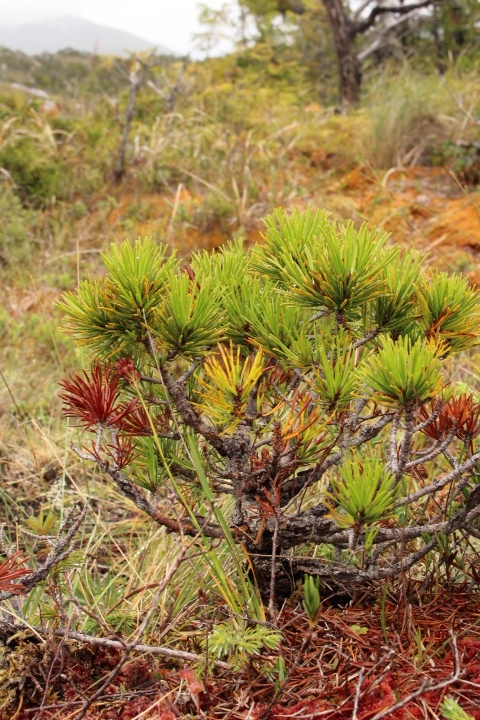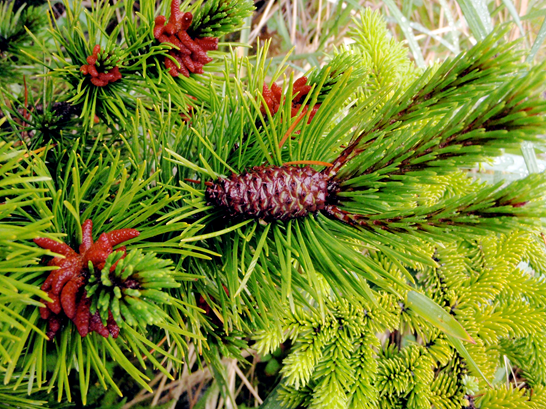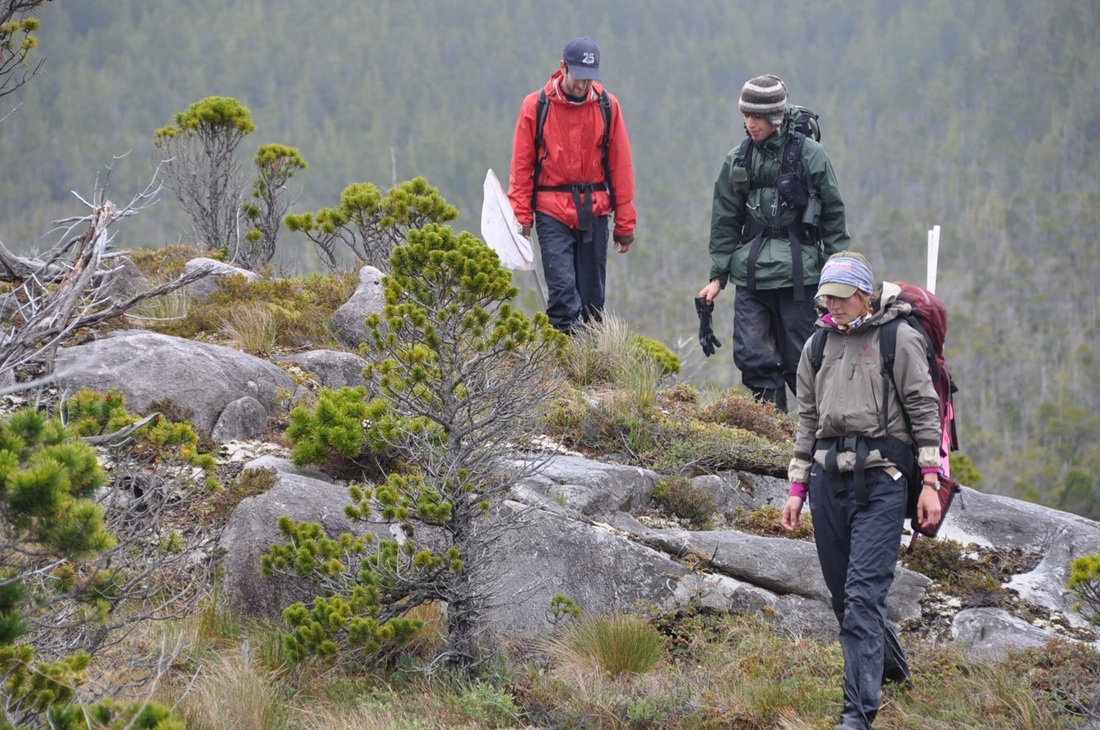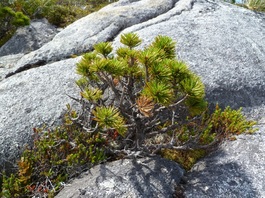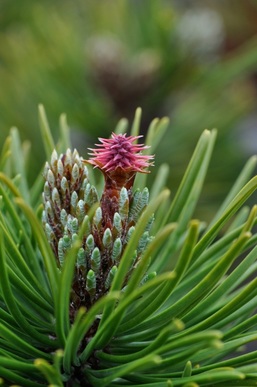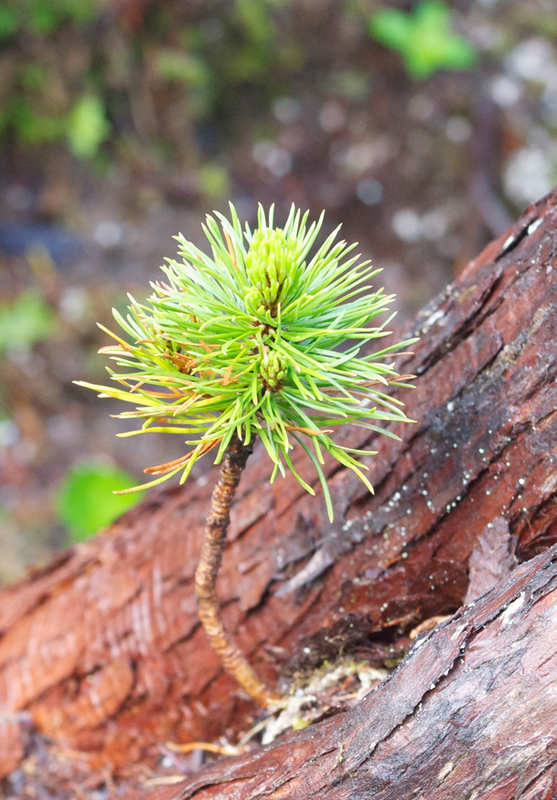Shore pine • Pinus contorta var. contorta
Heiltsuk/Haíɫzaqv - ƛ̓ín̓a • Nuxalk - lhmk'mlhp
Identification
Shore pine is generally short and crooked, usually growing to no more than 20 m tall, but it may reach 30 m in good conditions. Shore pine becomes stunted and takes a dwarf form in subalpine and muskeg locations, where 100-year-old or older trees remain no more than 2 m tall and 5 cm in diameter. These trees often have particularly twisted trunks and branches. Shore pine bark is scaly or furrowed into plates and is usually dark brown to black. Its long, deep green needles grow in pairs. It often has more needles forming a crown at the top of the tree.
Habitat & Range
Shore pine grows from low to middle elevations along BC's coast, but may be found in the subalpine further north. It is often found in nutrient-poor or exposed sites, like bogs, dunes, rocky crests and exposed shorelines, where it may take the aforementioned dwarf bonsai form.
Similar Species
Lodgepole pine (Pinus contorta var. latifolia) is similar to shore pine, but is taller and straighter, with thinner and redder bark. Ponderosa pine (P. ponderosa) is usually found inland, but does occur on the coast of Oregon and the Puget Trough. Its needles grow in bunches of three and the bark is a lighter, redder brown than shore pine.
Human Uses
Shore pine was used by many coastal First Nations, including the Nisga'a, Haida, Sechelt, Saanich, Lower Stl'atl'imx, Coast Salish, Nuu-chah-nuulth, Kwakwaka'wakw, Nuxalk, Tsimshian and Tlingit. Various parts of the tree were used, including the pitch for waterproofing and as an adhesive, roots as rope, sheets of bark as splints, and a variety of medicinal applications.
iNaturalist
https://www.inaturalist.org/taxa/80130-Pinus-contorta-contorta
Shore pine is generally short and crooked, usually growing to no more than 20 m tall, but it may reach 30 m in good conditions. Shore pine becomes stunted and takes a dwarf form in subalpine and muskeg locations, where 100-year-old or older trees remain no more than 2 m tall and 5 cm in diameter. These trees often have particularly twisted trunks and branches. Shore pine bark is scaly or furrowed into plates and is usually dark brown to black. Its long, deep green needles grow in pairs. It often has more needles forming a crown at the top of the tree.
Habitat & Range
Shore pine grows from low to middle elevations along BC's coast, but may be found in the subalpine further north. It is often found in nutrient-poor or exposed sites, like bogs, dunes, rocky crests and exposed shorelines, where it may take the aforementioned dwarf bonsai form.
Similar Species
Lodgepole pine (Pinus contorta var. latifolia) is similar to shore pine, but is taller and straighter, with thinner and redder bark. Ponderosa pine (P. ponderosa) is usually found inland, but does occur on the coast of Oregon and the Puget Trough. Its needles grow in bunches of three and the bark is a lighter, redder brown than shore pine.
Human Uses
Shore pine was used by many coastal First Nations, including the Nisga'a, Haida, Sechelt, Saanich, Lower Stl'atl'imx, Coast Salish, Nuu-chah-nuulth, Kwakwaka'wakw, Nuxalk, Tsimshian and Tlingit. Various parts of the tree were used, including the pitch for waterproofing and as an adhesive, roots as rope, sheets of bark as splints, and a variety of medicinal applications.
iNaturalist
https://www.inaturalist.org/taxa/80130-Pinus-contorta-contorta
References
Pojar, J. and MacKinnon, A. (2005). Plants of Coastal British Columbia, Revised. Vancouver, BC: Lone Pine Publishing. P. 38.
Authors and editors of page
Chanda Brietzke and Brian Starzomski (2013).
Pojar, J. and MacKinnon, A. (2005). Plants of Coastal British Columbia, Revised. Vancouver, BC: Lone Pine Publishing. P. 38.
Authors and editors of page
Chanda Brietzke and Brian Starzomski (2013).
